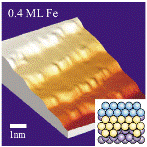Department of Physics and Astronomy: Publications and Other Research

Axel Enders Publications
Document Type
Article
Date of this Version
9-1995
Abstract
Using a simple optical deflection technique, we measured continuously the mechanical stress during the growth of Fe films of 0.1–1.5 nm thickness on Si(111) in ultrahigh vacuum (UHV). The stress versus coverage dependence is discussed in view of the different growth modes during the various stages of Fe deposition. The deposition of up to 0.3 nm Fe induces a compressive stress of -1 N/m. We assign this stress to the formation of a reactive Fe–Si interface layer with a silicide-like structure. Subsequent Fe deposition at 300 K leads to a small tensile stress of 0.7 N/m, whereas the deposition at 600 K induces a high tensile film stress of 18 N/m. At 600 K substrate temperature, a solid-state reaction between Fe and Si sets in, and the silicide β-FeSi2 is formed. The decrease of the atomic volume of Si by 7% in this silicide is proposed to be the cause for the tensile stress.


Comments
Published in Appl. Phys. Lett. 67 (13), 25 September 1995. Copyright © 1995 American Institute of Physics. Used by permission.